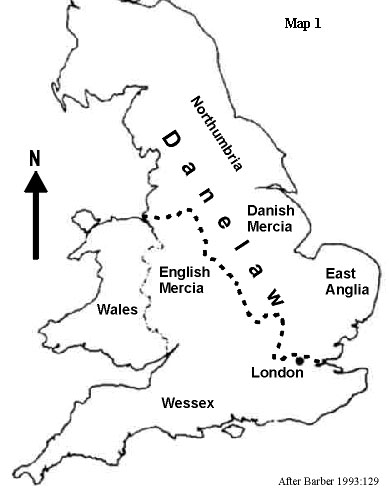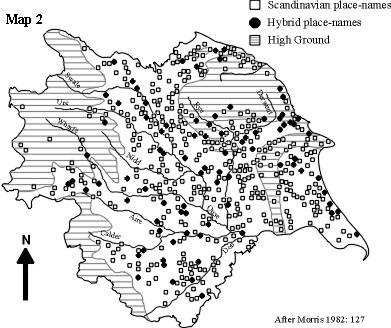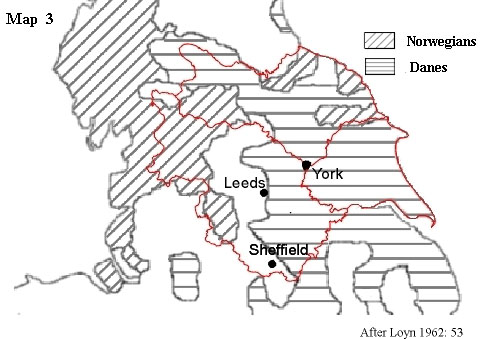

 |
|
 |
| "The Anglo-Saxons had been living in England in relative peace for some three centuries when they began to be disturbed by their restive northern relatives. The annal in the Anglo-Saxon Chronicle for the year 787 mentions the arrival of three ships, and the occupants killing a reeve who tried to compel them to visit the royal manor. These are described as 'the first ships of the Danes to come to England'. Within a few decades whole fleets and armies came, staying not just for the summers but for years. Within a century this minor visitation and its attendant skirmish was to become a full-scale invasion…." Hughes (2000: 91) |
In relation to the Scandinavian invasion, place-name research, and that of other academic disciplines, has been employed to identify both the routes of ingress used and the locations settled. However, some effort has been made to use the accumulated data as a means of establishing the chronology of settlement and the subsequent circumstances of the existing population. All these questions, as they relate to Yorkshire, are examined below.
Overview
 |
Loyn (1962) observes that, in the initial stages, colonization fell into two parts: firstly, the invasion of the Danes towards the end of the 9th century; secondly, the arrival of the Norwegians during the early decades of the 10th. He remarks that, in contrast to that of the Danes, Norwegian settlement was generally peaceful. Cameron (1988) notes that in addition to the Danes and Norwegians, there is evidence to suggest that there were also Fresians among the newcomers.
Barber (1993) adds that within a few years of their arrival, the Danes were in control of the majority of Eastern England. The West Saxons under the leadership of King Alfred checked further incursions into other areas and, under the Treaty of Wedmore (886 AD), the Danes agreed to remain east of a line running roughly diagonally across the country between Chester and London. Because this area was subject to Danish Law it became known as the Danelaw (Map 1).
Barber (1993) goes on to say that a later invasion in the latter part of the 10th century resulted in the seizure of the English throne and a Danish monarchy, which lasted for 25 years. Although the West Saxons eventually recovered the North and the East, there had by then been a large influx of Scandinavian settlers into the region.
Settlement
Yorkshire itself, says Morris (1982), was exposed to Scandinavian colonization and rule for nearly a century between the years AD 867 to 954. At the end of the 11th century, from the record of Yorkshire place-names in the Domesday Book, 69% of the locations in the WR were of Anglian origin with the remainder being Scandinavian. In the ER there was more of an even balance with only slightly less than 50% of the place-names being Scandinavian. In the NR 46% of the settlements were attributable to the Danes. Morris proposes that the distribution of Scandinavian place-names suggests the settlement patterns illustrated in Map 2. It should be noted that reference to hybrid names includes those modified under Scandinavian influence.
 |
Morris further proposes that the settlement patterns are similar to those of the Angles in that:
Cameron (1996) distinguishes between the areas settled by the Norwegians and those occupied by the Danes. The Norwegians, migrating from the Gaelic speaking areas of Man, Ireland and Strathclyde, mainly established themselves in the north-west, around Cumbria and Lancashire. Map 3 illustrates the approximate settlement patterns. However, as Loyn (1962) points out, there was some movement across the Pennines into the north-west of the West Riding of Yorkshire and into the North Riding (It was Norwegians from Dublin who established a kingdom in York.) He adds, with regard to the North Riding, that an abundance of Norwegian place-names in the area suggests major settlement there. Conversely, there is also evidence of Danish settlement west of the Pennines in areas around the Lake District and Manchester. However, the highest concentration of Danes occurred in the areas occupied by present-day Norfolk, Leicestershire, Lincolnshire, Nottinghamshire, Derbyshire and Yorkshire.
Chronology
 |
Concerning the chronological aspect of settlement, Morris (1982) states that the history of the colonization of Northern England during the 9th and 10th centuries is somewhat obscure. However, based on the research of Sawyer (1971), Cameron and Fellowes Jensen, the order of settlement is perceived to be as follows:
With regard to Yorkshire, Fellows Jensen (1972) lists 48 locations (18 in the WR, 7 in the ER, and 23 in the NR) with names of Scandinavian origin, but where evidence exists which shows that all were originally Anglian settlements. The suggestion is, therefore, that substitution of Scandinavian names for English ones was not uncommon. However, this is not necessarily indicative of the indigenous population being totally dispossessed.
The Angles - displacement or assimilation?
In the 10th century there was an abundance of available of land and large number of thorpe type place-names (155 in Yorkshire) suggests that the in-comers had no difficulty in locating unoccupied or undeveloped sites. Furthermore, Morris (1982) claims that hybrid names and the large number of English place-names modified "under influence of Scandinavian speech" implies that a relationship existed between the two cultures.
By way of an example, he refers to Hutton Rudby in the North Riding. Located on the river Leven, Hutton is situated on one bank and Rudby on the other. Both are recorded in the Domesday Book and were well established by the 11th century. It might be inferred from the names, Hutton being English ( Old English hoh "high" + tun "settlement") and Rudby being Scandinavian (Rudi [a Scandinavian personal name] + by "farmstead / village" ), and the fact that these two closely located communities continued to exist at the end of the 11th century, that both settltements must have lived in peace and harmony with each other.
Loyn (1962) considers that this situation was not uncommon. He claims that, although the degree of Scandinavian settlement within the Danelaw differed from locality to locality there was one uniform characteristic. That is, there was no significant displacement of the indigenous inhabitants. Scandinavian settlement was largely a matter of supplementation, rather than replacement, of the existing population.
References
Barber, C. (1993) The English language: a historical introduction, Cambridge: Cambridge University Press.
Cameron, K. (1988; 1996) English Place-Names, London: B.T. Batsford Ltd.
Fellows Jensen, G. (1972) Scandinavian Settlement-Names in Yorkshire, Copenhagen.
Hughes, G. (2000) A History of English Words, Oxford: Blackwell.
Loyn, H. R. (1962) Anglo-Saxon England and the Norman Conquest, London: Longmans, Green and Co Ltd.
Morris, R.W. (1982) Yorkshire through Place Names, North Pomfret, Vermont: David and Charles Inc.
Sawyer, P.H. (1971) The Age of the Vikings, Second Edition, London: Arnold.